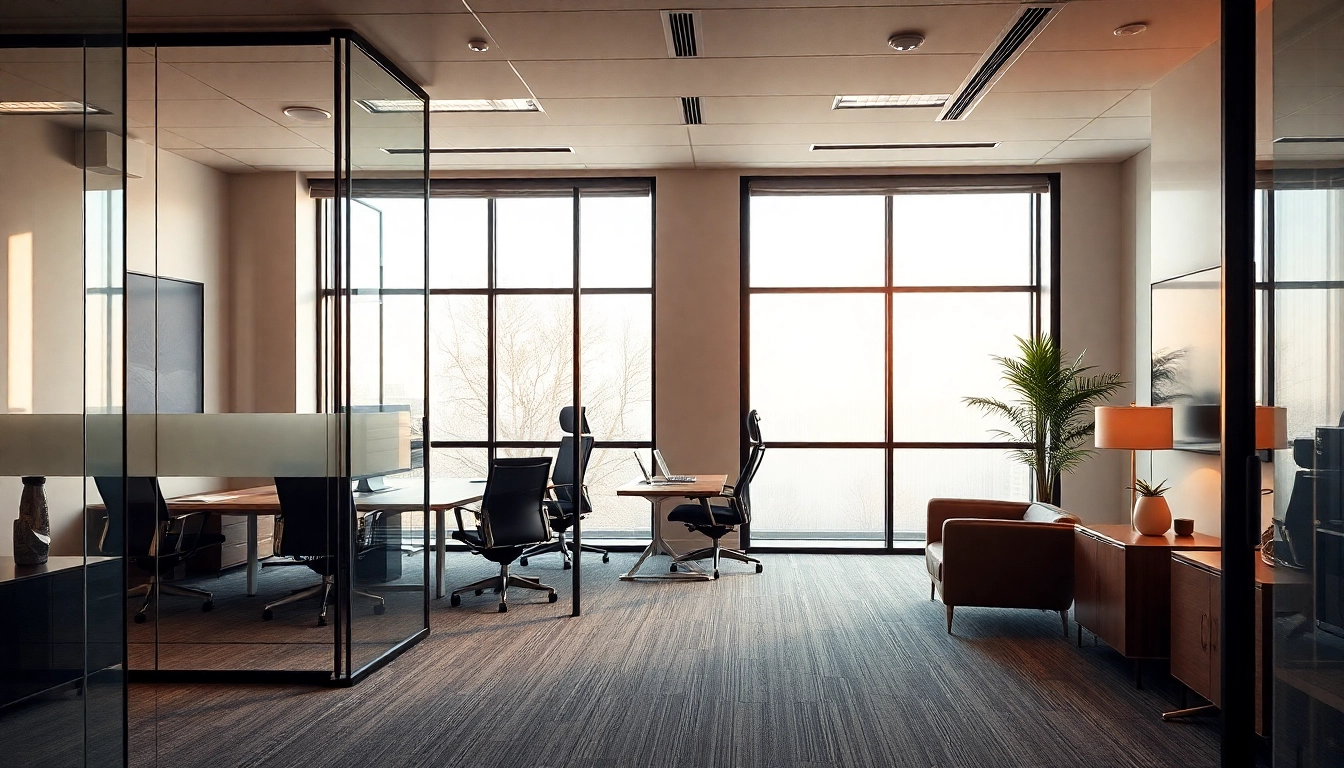Maximize Flexibility and Light with Movable Glass Partitions for Modern Spaces

Understanding Movable Glass Partitions
What Are Movable Glass Partitions?
Movable glass partitions are innovative design solutions that allow for the flexible reconfiguration of spaces without sacrificing natural light or aesthetic appeal. These partitions consist of large panels of tempered glass that can be maneuvered easily to create privacy or open areas as needed. Unlike traditional walls, which are typically fixed in place, movable glass partitions enable users to adapt their environments quickly and effectively, making them increasingly popular in modern architecture and interior design.
Benefits of Movable Glass Partitions
The benefits of incorporating movable glass partitions into your space are vast. Here are some key advantages:
- Flexibility: Movable glass partitions allow users to create or eliminate spaces at will, making them ideal for environments where needs change frequently, such as offices, conference rooms, or event spaces.
- Natural Light: Unlike traditional walls, which can block out light, glass partitions maintain an open and airy feel, enhancing the visual space while improving morale and energy levels among occupants.
- Acoustic Control: Many movable glass systems incorporate soundproofing materials that help to minimize noise transfer between spaces, allowing for work environments that can be both collaborative and private.
- Aesthetic Appeal: The sleek and modern look of glass can enhance the overall appearance of a space, adding a touch of elegance and promoting a contemporary feel.
- Cost-Effectiveness: While the initial investment may be higher compared to traditional partitions, the long-term savings in terms of reduced remodeling costs and increased space utility often outweigh the upfront cost.
Applications in Various Industries
From corporate offices to educational facilities, movable glass partitions find a home in numerous sectors. Their versatility is a key factor in their widespread adoption:
- Corporate Offices: These partitions allow for quick reconfiguration when changing team structures or hosting meetings, promoting collaboration while providing necessary privacy.
- Hospitality: Hotels and restaurants utilize glass partitions to create adaptable dining areas that can accommodate different group sizes or special events with ease.
- Healthcare: In medical facilities, glass partitions help in creating observation rooms or consultation areas without sacrificing the visibility or accessibility of spaces.
- Education: Schools and universities benefit from movable partitions to quickly adapt classrooms for varied teaching styles or group sizes, maximizing educational resources.
- Retail: Retail spaces use movable glass partitions to create flexible layouts for pop-up shops or seasonal events, enhancing customer experience while ensuring optimal use of space.
Designing with Movable Glass Partitions
Integrating with Office Layouts
The implementation of movable glass partitions in office layouts is transformative. Businesses today are trending towards open space concepts, but there is still a need for private areas for focused work. By incorporating glass partitions, companies can achieve a balance between open collaboration and sufficient privacy. Here are some design considerations:
- Design the layout with traffic flow in mind. Ensuring easy navigation around glass walls enhances the user experience.
- Incorporate branding elements or frosted glass to maintain company identity while using transparent materials.
- Consider multifunctional spaces where a single area can serve various purposes, based on the configuration of movable partitions.
Residential Applications and Trends
Movable glass partitions are not limited to commercial spaces; they are increasingly being embraced in residential settings. Homeowners utilize these partitions to define spaces without the weight of traditional walls. Recent trends show:
- Open-concept homes are being improved by integrating glass partitions that can separate spaces for privacy when desired.
- Home offices benefit from movable glass partitions that provide isolation from distractions.
- The trend towards minimalist interior designs makes glass partitions favorable due to their unobtrusive nature.
Choosing the Right Design Style
When selecting movable glass partitions, the design style can significantly influence the effectiveness and aesthetic appeal of the installation. Options range from frameless designs that offer a sleek look to framed systems that add a more structured feel. Considerations for choosing the right style include:
- Functionality: Determine the primary use of the partitions—whether they need to be soundproof, provide privacy, or simply add visual depth.
- Aesthetics: Consider how additional design elements, such as colored glass or integrated lighting, can enhance visual appeal.
- Hardware Choices: The choice of hinges and sliding mechanisms is crucial for functionality; ensure they align with the intended use of the partitions.
Installation and Maintenance of Movable Glass Partitions
Steps for Proper Installation
Installing movable glass partitions requires careful planning and execution to ensure durability and functionality. Key steps include:
- Site Assessment: Conduct a thorough assessment of the installation area to measure space and define potential challenges.
- Prepare the Area: Clear the installation site of any obstacles, ensuring adequate space for the movement of glass panels during installation.
- Install Tracks and Hardware: Securely install ceiling or floor tracks, ensuring they are level and appropriately anchored to support the weight of glass panels.
- Hang the Panels: Carefully lift and position each glass panel onto the track, adjusting as necessary for alignment.
- Final Adjustments: Make any necessary adjustments to ensure proper functionality (sliding mechanisms, soundproof seals, etc.) and visually inspect the installation for defects.
Maintenance Best Practices
To prolong the life of movable glass partitions, regular maintenance is essential. Here are some best practices:
- Regularly clean glass surfaces using non-abrasive cleaners to remove fingerprints, streaks, and dirt.
- Inspect the tracks and mechanisms periodically to ensure they are free of debris and functioning smoothly.
- Address any minor damages immediately to prevent further issues. This includes fixing scratches on glass or worn-out seals to maintain sound insulation.
Common Issues and Solutions
While movable glass partitions are highly effective, they may encounter some common issues over time. Here are potential problems and their solutions:
- Panel Misalignment: If panels become misaligned, check the mounting hardware and make adjustments as necessary to reposition the glass.
- Increased Noise Levels: If soundproofing is compromised, inspect seals and make repairs or replacements to improve insulation.
- Sticking Mechanisms: If the sliding mechanisms stick, ensure the tracks are clean, and lubricate moving parts to ensure smooth operation.
Comparing Movable Glass Partitions with Traditional Options
Cost Analysis and Value Insights
When considering partitions for a space, it’s crucial to understand the cost-benefit analysis between movable glass partitions and traditional options. Initial investments can vary significantly:
- Movable glass partitions typically have a higher upfront cost due to the materials and technology involved.
- However, they often lead to long-term savings through increased space efficiency and reduced remodeling costs as business needs change.
- Additionally, they can enhance the resale value of a property due to their aesthetic appeal and adaptable function.
Performance Metrics: Sound & Insulation
Performance is critical when evaluating partitions. Here are key metrics to consider:
- Sound Transmission Class (STC): Movable glass partitions typically score well in STC ratings, indicating their effectiveness in reducing noise transfer between spaces.
- Thermal Insulation: While traditional partitioning materials may offer better thermal insulation, modern glass partitions can be equipped with double glazing to enhance thermal performance.
- Durability and Maintenance: Glass is generally more durable than drywall and can withstand impacts and stains, contributing to less frequent maintenance needs.
Visual Appeal Versus Traditional Walls
The visual aspect of space can be transformative. Here is a comparison:
- Transparency: Movable glass partitions promote openness and light, which is often not achievable with traditional materials.
- Customization: Glass panels can be customized with graphics or textures to align with branding or personal aesthetics.
- Aesthetic Versatility: Glass partitions can adapt to varying styles, be it industrial, minimalist, or contemporary, providing flexibility in design choices.
Future Trends in Movable Glass Partition Solutions
Innovations in Design and Functionality
The future of movable glass partitions is bright, with several innovations on the horizon. Some anticipated trends include:
- Smart Glass Technology: Look for advancements in smart technology, allowing glass to switch from transparent to opaque, providing instant privacy.
- Eco-Friendly Materials: Sustainable glass options with improved energy efficiency are gaining traction as consumer awareness regarding sustainability increases.
- Enhanced Mobility: Continued innovations in hardware will focus on making movable partitions easier to operate, reducing manual effort and enhancing user experience.
Sustainability and Eco-Friendly Options
As the demand for environmentally responsible building practices rises, the use of eco-friendly materials in the manufacturing of movable glass partitions is becoming a significant trend. This includes:
- Recycled materials in glass production.
- Energy-efficient glazing options that help regulate temperature.
- Minimal waste manufacturing processes in partition production.
Market Insights and Consumer Preferences
Understanding market trends helps gauge the growing preference for movable glass partitions. Recent studies indicate an uptick in consumer demand primarily driven by:
- Millennial and Gen Z preferences for flexible and functional living and working spaces.
- Increased urbanization leading to a demand for smart space solutions to optimize smaller living areas.
- A shift towards open and collaborative work environments emphasizing communication and team dynamics.



Leave a Comment